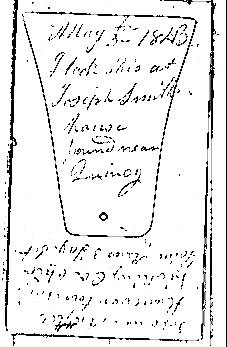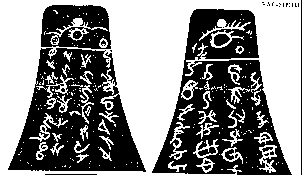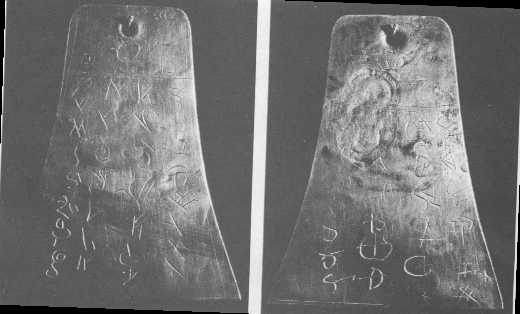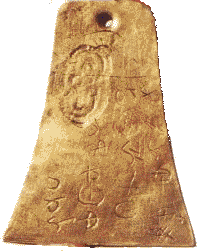![]() In 1843 three men, unknown to
others beside themselves, manufactured a set of six bell-shaped brass plates. Their size was
about 2 7/8 high by 2 1/4 inches. These they hid in the ground and later in April several men dug
in an ancient burial mound near Kinderhook, Pike County, Illinois. Here the men "discovered"
these ancient looking artifacts. With the plates were the remains of a man. When the plates were
cleaned and it was found that they contained what looked like hieroglyphics on both sides. Some
men made a statement about the discovery and the plates were publicly displayed in the town of
Quincy.
In 1843 three men, unknown to
others beside themselves, manufactured a set of six bell-shaped brass plates. Their size was
about 2 7/8 high by 2 1/4 inches. These they hid in the ground and later in April several men dug
in an ancient burial mound near Kinderhook, Pike County, Illinois. Here the men "discovered"
these ancient looking artifacts. With the plates were the remains of a man. When the plates were
cleaned and it was found that they contained what looked like hieroglyphics on both sides. Some
men made a statement about the discovery and the plates were publicly displayed in the town of
Quincy.
![]() The public was interested in the
meaning and whether they told
anything about the person with whom they were found with. The
Quincy Whig published the following:
The public was interested in the
meaning and whether they told
anything about the person with whom they were found with. The
Quincy Whig published the following:
By whom these plates were deposited there, must ever remain a secret, unless some one skilled in deciphering hieroglyphics, may be found to unravel the mystery. Some pretend to say, that Smith the Mormon leader, has the ability to read them. If he has, he will confer a great favor on the public by removing the mystery which hangs over them. We learn there was a Mormon present when the plates were found, who it is said, leaped for joy at the discovery, and remarked that it would go to prove the authenticity of the Book of Mormon ... There were but few bones found in the mound; and it is believed, that it was but the burial place of a small number, perhaps of a person, or family of distinction, in ages long gone by ...The plates above alluded to, were exhibited in this city [Quincy] last week, and are now, we understand, in Nauvoo, subject to the inspection of the Mormon Prophet. The public curiosity is greatly excited, and if Smith can decipher the hieroglyphics on the plates, he will do more towards throwing light on the early history of this continent, than any man now living.1
![]() These plates were brought to
Nauvoo and shown to Joseph
Smith. He had previously claimed to have translated an earlier set
of gold plates. Smith examined the ancient characters and commented
that the writing was like those on the Book of Mormon plates. He
said they contained a history of the person with whom they were
found. That person was said to be a Jaredite (the earliest race of
ancient Americans) who descended from a Pharaoh of Egypt through
Ham, one of the sons of Noah.
These plates were brought to
Nauvoo and shown to Joseph
Smith. He had previously claimed to have translated an earlier set
of gold plates. Smith examined the ancient characters and commented
that the writing was like those on the Book of Mormon plates. He
said they contained a history of the person with whom they were
found. That person was said to be a Jaredite (the earliest race of
ancient Americans) who descended from a Pharaoh of Egypt through
Ham, one of the sons of Noah.
![]() This linked the bell shaped
plates to the Book of Mormon and
the Book of Abraham both dictated by Joseph Smith. The script was
said to be Egyptian characters like those on the gold plates of the
Book of Mormon. It was claimed that the contents newly found
Kinderhook Plates told something about the race of the person with
whom they were found. His descent was through Pharaoh, a topic of
the Book of Abraham.2
This linked the bell shaped
plates to the Book of Mormon and
the Book of Abraham both dictated by Joseph Smith. The script was
said to be Egyptian characters like those on the gold plates of the
Book of Mormon. It was claimed that the contents newly found
Kinderhook Plates told something about the race of the person with
whom they were found. His descent was through Pharaoh, a topic of
the Book of Abraham.2
![]() On 1 May 1843, William
Clayton, one of Joseph Smith's
secretaries made a tracing of one plate in his journal and recorded
the following regarding him seeing the plates and Smith's comments
relating to the translation of part of the writings:
On 1 May 1843, William
Clayton, one of Joseph Smith's
secretaries made a tracing of one plate in his journal and recorded
the following regarding him seeing the plates and Smith's comments
relating to the translation of part of the writings:
I have seen 6 brass plates which were found in Adams [Pike] County by some persons who were digging in a mound. They found a skeleton about 6 feet from the surface of the earth which was 9 foot high. [At this point there is a tracing of a plate in the journal.] The plates were on the breast of the skeleton. This diagram shows the size of the plates being drawn on the edge of one of them. They are covered with ancient characters of language containing from 30 to 40 on each side of the plates. Pres[iden]t J[oseph]. has translated a portion and says they contain the history of the person with whom they were found and he was a descendant of Ham through the loins of Pharaoh king of Egypt, and that he received his kingdom from the ruler of heaven and earth.3
![]() The next day, 2 May 1843,
non-member Charlotte Haven wrote a
letter that mentioned the plates. She stated Mr. Joshua Moore
showed the six bell shaped plates to Joseph Smith. He reported to
her that Smith
The next day, 2 May 1843,
non-member Charlotte Haven wrote a
letter that mentioned the plates. She stated Mr. Joshua Moore
showed the six bell shaped plates to Joseph Smith. He reported to
her that Smith
said that the figures or writing on them was similar to that in which the Book of Mormon was written, and if Mr. Moore could leave them, he thought that by the help of revelation he would be able to translate them.4
![]() Brigham Young, President of
the Council of the Twelve Apostles, like William
Clayton also traced one of the plates in his diary and put the
following brief comment inside the outline drawn in the diary:
Brigham Young, President of
the Council of the Twelve Apostles, like William
Clayton also traced one of the plates in his diary and put the
following brief comment inside the outline drawn in the diary:

![]() May 3th 1843
May 3th 1843
![]() I took this at
I took this at
![]() Joseph Smiths
Joseph Smiths
![]() house
house
![]() found near
found near
![]() Quincy5
Quincy5
![]() On 7 May 1843, Parley P.
Pratt, one of the Twelve Apostles,
included the following comments in a letter:
On 7 May 1843, Parley P.
Pratt, one of the Twelve Apostles,
included the following comments in a letter:
Six plates having the appearance of Brass have lately been dug out of a mound by a gentleman in Pike Co. Illinois. They are small and filled with engravings in Egyptian language and contain the genealogy of one of the ancient Jaredites back to Ham the son of Noah.6
![]() The Kinderhook Plates were at
Joseph Smith's home for a brief
time. Brother Reuben Hedlock in 1842 assisted Smith in making wood
cuts for the three facsimiles of the Book of Abraham. Hedlock also
prepared wood cut facsimiles of the Kinderhook Plates.
The Kinderhook Plates were at
Joseph Smith's home for a brief
time. Brother Reuben Hedlock in 1842 assisted Smith in making wood
cuts for the three facsimiles of the Book of Abraham. Hedlock also
prepared wood cut facsimiles of the Kinderhook Plates.

![]() There were
twelve facsimiles of the strange looking characters on them from the six small plates, two
facsimilies for the side of plate. The broadside was published and sold to interested saints. The
broadside stated:
There were
twelve facsimiles of the strange looking characters on them from the six small plates, two
facsimilies for the side of plate. The broadside was published and sold to interested saints. The
broadside stated:
The contents of the Plates, together with a Fac-Simile of the same, will be published in the "Times & Seasons," as soon as the translation is completed. Nauvoo, Hancock county, Illinois. June 24th, 1843.7

![]() Ten years after Joseph Smith's
death in 1844, W. P. Harris wrote a letter mentioning the Kinderhook "discovery." Bridge
Whitton told Harris that the little plates were engraved and then the plates were placed in the pit
where they were uncovered. Harris wrote in 1855:
Ten years after Joseph Smith's
death in 1844, W. P. Harris wrote a letter mentioning the Kinderhook "discovery." Bridge
Whitton told Harris that the little plates were engraved and then the plates were placed in the pit
where they were uncovered. Harris wrote in 1855:
But since that time, Bridge Whitton said to me that he cut and prepared the plates and he (B. Whitton) and R. Wiley engraved them themselves, and that there was nitric acid put upon them the night before that they were found to rust the iron ring and band. And that they were carried to the mound, rubbed in the dirt and carefully dropped into the pit where they were found.8


![]() One of the Kinderhook Plates
is located at the Chicago Historical Society. In 1980 this artifact was examined to determine of it
was of ancient or nineteenth century origin as incicated in the above Harris letter. Dr. Lynn
Johnson wrote in his conclusion to his short report:
One of the Kinderhook Plates
is located at the Chicago Historical Society. In 1980 this artifact was examined to determine of it
was of ancient or nineteenth century origin as incicated in the above Harris letter. Dr. Lynn
Johnson wrote in his conclusion to his short report:
The plate owned by the Chicago Historical Society, and known as the Kinderhook Plate, is made from a brass alloy consistent with the technology of the middle 19th Century. The characters on the plates were formed by etching with acid, probably nitric acid.9
![]() In 1981 Stanley B. Kimball
published an article in the Ensign magazine of August 1981 that stated the plates
were produced in the nineteenth century and were not ancient as originally thought. He tried to
down play the contemporary sources showing that Joseph Smith believed that the characters
could be translated and giving a rendition of some of them.10
In 1981 Stanley B. Kimball
published an article in the Ensign magazine of August 1981 that stated the plates
were produced in the nineteenth century and were not ancient as originally thought. He tried to
down play the contemporary sources showing that Joseph Smith believed that the characters
could be translated and giving a rendition of some of them.10
![]() The bell shaped plates were not
an ancient American relic. Joseph Smith's comments should be looked at concerning his ability
to correctly decipher ancient appearing characters.
The bell shaped plates were not
an ancient American relic. Joseph Smith's comments should be looked at concerning his ability
to correctly decipher ancient appearing characters.
1. The Quincy Whig 6 (3 May 1843). Also printed in the Times and Seasons 4 (1 May 1843):186-87, Nauvoo, Illinois. An editorial in the same issue of the Times and Seasons states, "We have no doubt however, but Mr. [Joseph] Smith will be able to translate them."
2. On the Book of Abraham see, H. Michael Marquardt, "The Book of Abraham Revisited," Journal of Pastoral Practice 5 (1982):101-12.
3. William Clayton Journal, entry of 1 May 1843, as cited in James B. Allen, Trials of Discipleship: The Story of William Clayton, a Mormon (Urbana and Chicago: University of Illinois Press, 1987), 117. This entry is only partly quoted in An Intimate Chronicle: The Journals of William Clayton, edited by George D. Smith (Salt Lake City: Signature Books in association with Smith Research Associates, 1991), 100. The Clayton journal was used in compiling the Nauvoo portion of the manuscript history of the church. See History of the Church 5:372.
4. Charlotte Haven to "My dear home friends," 2 May 1843, as cited in Overland Monthly 16 (December 1890):630.
5. Diary of Brigham Young, Family and Church History Department, Church of Jesus Christ of Latter-day Saints, Salt Lake City, Utah. Cited hereafter as LDS Archives.
6. LDS Archives as quoted in Stanley B. Kimball, "Kinderhook Plates Brought to Joseph Smith Appear to be a Nineteenth-Century Hoax," Ensign 11 (August 1981):73.
7. Broadside titled "Discovery of the Brass Plates," published at Nauvoo, Illinois, 24 June 1843. Copy in LDS Archives.
8. W. P. Harris to W. C. Flagg, 25 April 1855 in "A Hoax: Reminiscences of an Old Kinderhook Mystery," Journal of the Illinois State Historical Society 5 (July 1912):272.
9. D. Lynn Johnson, "Analysis of the Kinderhook Plate Owned by the Chicago Historical Society," (Nov. 1980), 4.
10. For further documentation relating to the Kinderhook Plates see H. Michael Marquardt Papers, Western Americana, J. Willard Marriott Library, University of Utah, Salt Lake City, Accession 900, Box 77, folders 15-17.